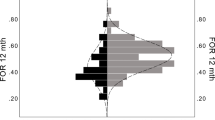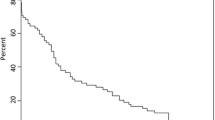Abstract
In this study, 78 patients with aqueductal stenosis were submitted to detailed neurodevelopmental assessment with a follow-up of 5–25 years. Sixty-eight percent of patients were categorized as normal; they either attended normal school courses or had regular jobs. Among these, 34% had some motor abnormalities (ataxia, mild hemiparesis, visual disturbances). Twenty-four percent (19 cases) were moderately disabled (trainable retardation) and 8% (6 cases) were severely handicapped. Epilepsy was observed in 13% of the cases. Incidence of recurrent and generalized seizures paralleled neurodevelopmental outcome (5% in normal, 16% in moderately disabled and 50% in severely disabled patients). Endocrine dysfunctions were evident in 28% of the cases and were characterized by precocious or delayed puberty, amenorrhea and somatic underdevelopment. No patient with ventricular enlargement and a cortical mantle width below 20 mm showed a good outcome. Large ventricles were compatible with normal mental development when compensated with a corresponding cranial vault enlargement. In patients with normal mental status and motor abnormalities, longterm CT scan findings revealed the presence of focal brain abnormalities (poroencephaly, brain atrophy, calcifications, extracerebral collections).
Similar content being viewed by others
References
Amacher AL, Reid WD (1984) Hydrocephalus diagnosed prenatally. Outcome of surgical therapy. Child's Brain 11:119–125
Ames RH (1967) Ventriculo-peritoneal shunts in the management of hydrocephalus. J Neurosurg 27:525–529
Becker DP, Nulsen FE (1968) Control of hydrocephalus by valve-regulated venous shunt. Avoidance of complications in prolonged shunt maintenance. J Neurosurg 28:215–226
Cagnoni G, Guizzardi G, Giardina F, Mennona P (1986) Follow-up and surgical considerations on a series of patients operated on for non-tumoral aqueductal stenosis. J Neurosurg Sci 30:77–79
Dennis M, Fitz CR, Netley CT, Sugar J, Harwood-Nash DCF, Hendrick EB, Hoffman HJ, Humphreys RP (1981) The intelligence of hydrocephalic children. Arch Neurol 38:607–615
Foltz E, Schurtleff DB (1963) Five years comparative study of hydrocephalus in children with and without operation (113 cases). J Neurosurg 20:1064–1079
Giuffrè R, Palma L, Fontana M (1986) Infantile non-tumoral aqueductal stenosis. J Neurosurg Sci 30: 41–468.
Hannigan WC, Morgan A, Saaban A, Bradle P (1991) Surgical treatment and long-term neurodevelopmental outcome for infants with idiopathic aqueductal stenosis. Child's Nerv Syst 7:386–390
Hirsch JF, Hirsch E, Sainte Rose CH, Renier D, Pierre-Kahn A (1986) Stenosis of the aqueduct of Sylvius. Etiology and treatment. J Neurosurg Sci 30:29–39
Jellinger G (1986) Anatomopathology of non-tumoral aqueductal stenosis. J Neurosurg Sci 30:1–16
Kelly PJ (1991) Stereotactic third ventriculostomy in patients with non-tumoral adolescent/adult onset aqueductal stenosis and symptomatic hydrocephalus. J Neurosurg 75:865–873
Kuecher TR, Mealey J Jr (1979) Long-term results after ventriculoatrial shunting for infantile hydrocephalus. J Neurosurg 50:179–186
Lapras CL, Bret PH, Patet JD, Huppert J, Honorato D (1986) Hydrocephalus and aqueduct stenosis. Direct surgical treatment by interventriculostomy (aqueduct cannulation). J Neurosurg Sci 30:47–53
McCullough DC, Balzer-Martin LA (1982) Current prognosis in overt neonatal hydrocephalus. J Neurosurg 57:378–383
Raimondi AJ, Soare P (1974) Intellectual development in shunted hydrocephalic children. Am J Dis Child 127:664–671
Rotilio A, D'Avella D, De Blasi F, Del Vivo RE, Sala G, Carteri A (1986) Disendocrine manifestations during non-tumoral aqueductal stenosis. J Neurosurg Sci 30:71–76
Stellman GR, Bannister CM, Hillier V (1986) The incidence of seizures disorder in children with acquired and congenital hydrocephalus. Z Kinderchir 41 [Suppl 1]: 38–41
Villani R, Gaini SM, Giovanelli M, Tomei G, Zavanone M, Motti EDF (1976) Skull changes and intellectual status in hydrocephalic children following CSF shunting. Dev Med Child Neurol 18 [Suppl 37]: 77–81
Villani R, Gaini SM, Giovanelli M, Tomei G, Sganzerla EP, Zavanone M (1986) Treatment of non-neoplastic stenosis of the aqueduct of Sylvius with extrathecal CSF shunts. J Neurosurg Sci 30:55–60
Author information
Authors and Affiliations
Rights and permissions
About this article
Cite this article
Villani, R., Tomei, G., Gaini, S.M. et al. Long-term outcome in aqueductal stenosis. Child's Nerv Syst 11, 180–185 (1995). https://doi.org/10.1007/BF00570262
Issue Date:
DOI: https://doi.org/10.1007/BF00570262




